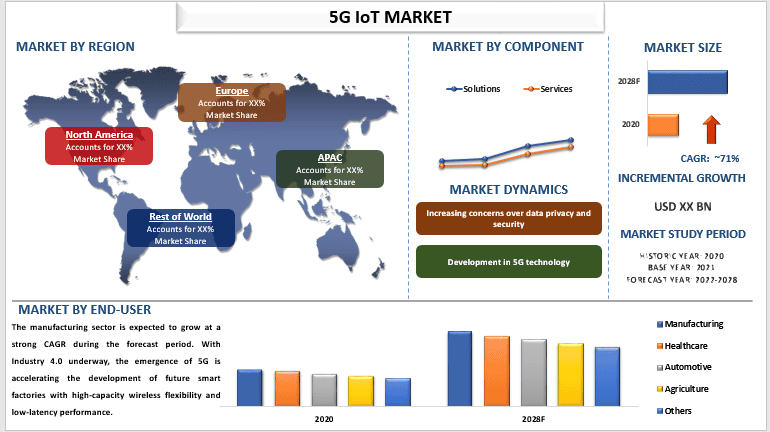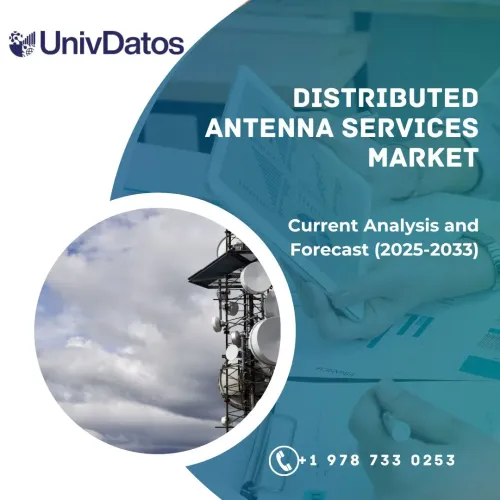- Home
- About Us
- Industry
- Services
- Reading
- Contact Us
5G IoT Market: Current Analysis and Forecast (2022-2028)
Emphasis on Component (Solutions [Hardware and Software] and Services); Network Type (5G Standalone and 5G Non-Standalone); End-User (Manufacturing, Healthcare, Automotive, Agriculture, and Others); and Region/Country

The 5G IoT Market is expected to grow at a strong CAGR of around 71% owing to the growing demand for new emerging use cases such as smart cities, telemedicine, industrial automation, and others. Transmission technology plays an important role in the Internet of Things (IoT) technology. It automatically makes the new 5G communication technology integral to his IoT. 5G supports increased efficiency in a number of IoT applications including telematics-related applications, telemetry applications, smart grid automation, remote surveillance, smart traffic management, manufacturing applications, medical applications, smart farming, smart cities and smart homes, and others. Further on, a decrease in latency, high connection density, great spectrum efficiency, and up to 100 times more traffic capacity are some of the most prominent features that influence the adoption of 5G in IoT. The increasing investment in smart cities is also contributing to the growth of the 5G IoT market. For instance, according to the SmartAmerica Challenge, local governments will invest USD 41 Tn over the next two decades to prepare infrastructure for the Internet of Things.
Some of the major players operating in the market include AT&T, Verizon, Deutsche Telekom AG, Vodafone Group, Orange, Telefónica S.A., SAMSUNG ELECTRONICS CO. LTD., Telefonaktiebolaget LM Ericsson, Huawei Technologies Co. Ltd., and Cisco Systems Inc. Several M&As along with partnerships have been undertaken by these players to facilitate customers with hi-tech and innovative products/technologies.
Insights Presented in the Report
“Amongst component, the hardware segment held a prominent share of the market in 2020”
Based on component, the market is segmented into solutions and services. The solutions segment is further divided into hardware and software. The solutions segment catered to a significant share of the market in 2020. This large share is due to the increasing demand for IoT device modules across multiple industries and verticals, including manufacturing, energy and utilities, transportation and logistics, and smart cities. Hardware used in 5G IoT systems includes devices for remote dashboards, devices for control, servers, routing or bridging devices, and sensors. These devices manage critical tasks and functions such as system activation, action specification, security, communications, and detection to support specific goals and actions.
“Amongst network type, the 5G standalone segment held a prominent share of the market in 2020”
By network type, the market is bifurcated into 5G standalone and 5G non-standalone. Among these two, the 5G standalone type accounted for a prominent share of the global 5G IoT market in 2020 and is expected to grow at a substantial CAGR mainly owing to some built-in capabilities such as network slicing, ultra-low latency, control and user panel separation (CUPS), multi-Gbps support, virtualization, and others. The 5G Standalone network type is a brand new wireless network for 5G networks. It mainly includes a 5G radio access network (RAN) and a 5G core network. This network type is expected to be more effective than the non-standalone 5G network type.
“Asia-Pacific to grow at a strong CAGR during the forecast period”
Asia-Pacific 5G IoT market is anticipated to grow at a substantial CAGR during the forecast period. The region is dynamically changing in terms of the introduction of new technologies in various fields. The growth of infrastructure and increased deployment of 4G and 5G networks in APAC, especially in Japan, South Korea, Singapore, India, and China, presents great opportunities for the implementation of 5G IoT services. For instance, According to GSMA Intelligence, China had 480 Mn 5G connections by the end of 2021, which was expected to grow to 650 Mn in just one year, accounting for more than 60% of the world’s 5G mobile connections.
Reasons to buy this report:
- The study includes market sizing and forecasting analysis validated by authenticated key industry experts.
- The report presents a quick review of overall industry performance at one glance.
- The report covers an in-depth analysis of prominent industry peers with a primary focus on key business financials, product portfolios, expansion strategies, and recent developments.
- Detailed examination of drivers, restraints, key trends, and opportunities prevailing in the industry.
- The study comprehensively covers the market across different segments.
- Deep dive regional level analysis of the industry.
Customization Options:
The global 5G IoT market can further be customized as per the requirement or any other market segment. Besides this, UMI understands that you may have your own business needs, hence feel free to connect with us to get a report that completely suits your requirements.
Table of Content
Research Methodology for the 5G IoT Market Analysis (2022-2028)
Analyzing the historical market, estimating the current market, and forecasting the future market of the global 5G IoT market were the three major steps undertaken to create and analyze the adoption of 5G IoT in major regions globally. Exhaustive secondary research was conducted to collect the historical market numbers and estimate the current market size. Secondly, to validate these insights, numerous findings and assumptions were taken into consideration. Moreover, exhaustive primary interviews were also conducted, with industry experts across the value chain of the global 5G IoT market. Post assumption and validation of market numbers through primary interviews, we employed a top-down/bottom-up approach to forecasting the complete market size. Thereafter, market breakdown and data triangulation methods were adopted to estimate and analyze the market size of segments and sub-segments of the industry pertains to. Detailed methodology is explained below:
Analysis of Historical Market Size
Step 1: In-Depth Study of Secondary Sources:
Detail secondary study was conducted to obtain the historical market size of the 5G IoT market through company internal sources such as annual reports & financial statements, performance presentations, press releases, etc., and external sources including journals, news & articles, government publications, competitor publications, sector reports, third-party database, and other credible publications.
Step 2: Market Segmentation:
After obtaining the historical market size of the 5G IoT market, we conducted a detailed secondary analysis to gather historical market insights and share for different segments & sub-segments for major regions. Major segments are included in the report as component, network type, and end-user. Further country-level analyses were conducted to evaluate the overall adoption of 5G IoT in that region.
Step 3: Factor Analysis:
After acquiring the historical market size of different segments and sub-segments, we conducted a detailed factor analysis to estimate the current market size of the 5G IoT market. Further, we conducted factor analysis using dependent and independent variables such as component, network type, and end-user of the 5G IoT market. A thorough analysis was conducted for demand and supply-side scenarios considering top partnerships, mergers and acquisitions, business expansion, and product launches in the 5G IoT market sector across the globe.
Current Market Size Estimate & Forecast
Current Market Sizing: Based on actionable insights from the above 3 steps, we arrived at the current market size, key players in the global 5G IoT market, and market shares of the segments. All the required percentage shares split, and market breakdowns were determined using the above-mentioned secondary approach and were verified through primary interviews.
Estimation & Forecasting: For market estimation and forecast, weights were assigned to different factors including drivers & trends, restraints, and opportunities available for the stakeholders. After analyzing these factors, relevant forecasting techniques i.e., the top-down/bottom-up approach were applied to arrive at the market forecast for 2028 for different segments and sub-segments across the major markets globally. The research methodology adopted to estimate the market size encompasses:
- The industry’s market size, in terms of revenue (USD) and the adoption rate of the 5G IoT market across the major markets domestically
- All percentage shares, splits, and breakdowns of market segments and sub-segments
- Key players in the global 5G IoT market in terms of products offered. Also, the growth strategies adopted by these players to compete in the fast-growing market
Market Size and Share Validation
Primary Research: In-depth interviews were conducted with the Key Opinion Leaders (KOLs) including Top Level Executives (CXO/VPs, Sales Head, Marketing Head, Operational Head, Regional Head, Country Head, etc.) across major regions. Primary research findings were then summarized, and statistical analysis was performed to prove the stated hypothesis. Inputs from primary research were consolidated with secondary findings, hence turning information into actionable insights.
Split of Primary Participants in Different Regions

Market Engineering
The data triangulation technique was employed to complete the overall market estimation and to arrive at precise statistical numbers for each segment and sub-segment of the global 5G IoT market. data was split into several segments & sub-segments post studying various parameters and trends in the areas of the component, network type, and end-user in the global 5G IoT market.
The main objective of the Global 5G IoT Market Study
The current & future market trends of the global 5G IoT market were pinpointed in the study. Investors can gain strategic insights to base their discretion for investments on the qualitative and quantitative analysis performed in the study. Current and future market trends determined the overall attractiveness of the market at a regional level, providing a platform for the industrial participant to exploit the untapped market to benefit from a first-mover advantage. Other quantitative goals of the studies include:
- Analyze the current and forecast market size of the 5G IoT market in terms of value (USD). Also, analyze the current and forecast market size of different segments and sub-segments
- Segments in the study include areas of the component, network type, and end-user
- Define and analysis of the regulatory framework for the 5G IoT industry
- Analyze the value chain involved with the presence of various intermediaries, along with analyzing customer and competitor behaviors of the industry
- Analyze the current and forecast market size of the 5G IoT market for the major region
- Major countries of regions studied in the report include Asia Pacific, Europe, North America, and the Rest of the World
- Company profiles of the 5G IoT market and the growth strategies adopted by the market players to sustain in the fast-growing market
- Deep dive regional level analysis of the industry
Related Reports
Customers who bought this item also bought










